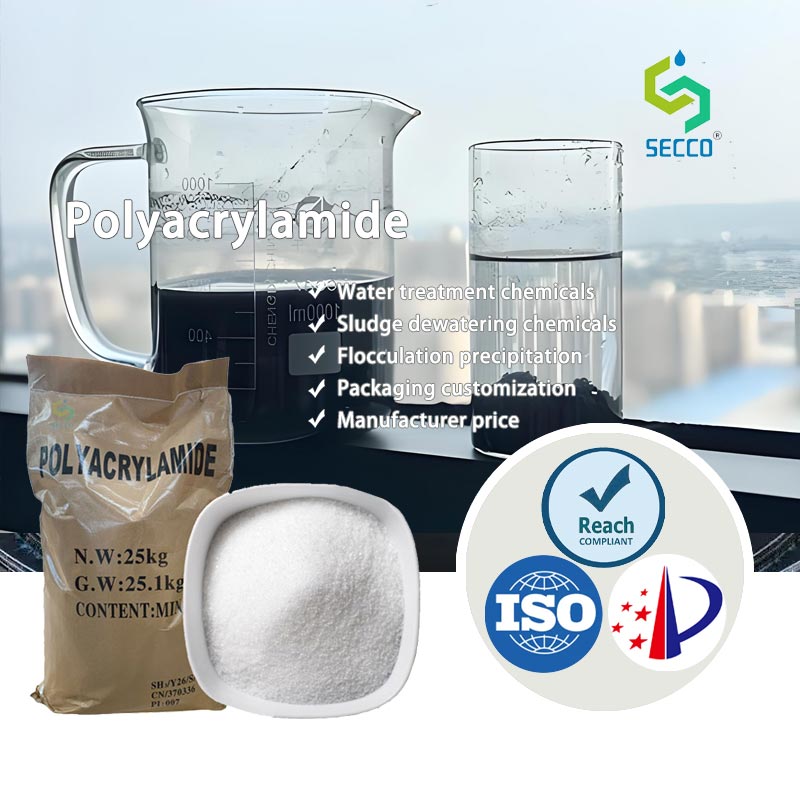Secco Polyacrylamide (PAM) is a highly effective polymeric flocculant widely used in coal washing wastewater treatment. It primarily removes suspended solids (SS) and colloidal particles through flocculation and sedimentation.

Below is a comprehensive technical analysis:
1. Technical Principles
Flocculation Mechanism:
PAM’s active groups (—CONH₂) adsorb onto coal slurry particles, neutralizing surface charges and forming "bridges" to aggregate fine particles into larger flocs for rapid settling.
Anionic PAM (APAM): Suitable for alkaline wastewater (typical in coal washing) with negatively charged particles.
Non-ionic PAM (NPAM): Used for neutral or weakly acidic wastewater.
Cationic PAM (CPAM): Rarely used unless treating organic-rich or positively charged colloids.
Synergistic Effects:
Often combined with inorganic coagulants (e.g., PAC) for charge neutralization followed by PAM-enhanced flocculation.
2. Key Technical Parameters
Dosage:
Typically 0.1–10 mg/L, determined via jar tests. Excess PAM may cause re-stabilization or fragile flocs.
Dissolution & Preparation:
PAM must be dissolved to 0.1%–0.5% solution with ≥40 min stirring to avoid clumping.
Mixing Conditions:
Rapid mixing (200–300 rpm) for dispersion, followed by slow mixing (20–50 rpm) for floc growth.
3. Advantages
High Efficiency: Reduces settling time by >50%, achieving 90%–95% SS removal.
Sludge Dewatering: Forms dense flocs, improving filter press efficiency.
Cost-Effectiveness: Low chemical cost (~$0.05–0.12 per ton of water).
Environmental Safety: PAM is non-toxic, but residual acrylamide must be <0.05%.
4. Common Challenges & Solutions
Incorrect PAM Selection:
Conduct jar tests to optimize type (APAM/NPAM) and molecular weight (typically 8–12 million).
pH Sensitivity:
APAM works best at pH 7–10; acidic wastewater requires pH adjustment or NPAM.
Incomplete Dissolution:
Use dedicated dissolving equipment to prevent "fish eyes."
Floc Breakage:
Over-mixing or overdosing may destabilize flocs; optimize operational parameters.
5. Case Study
Coal Mine Wastewater Plant:
Influent: SS 2000–5000 mg/L, pH 8–9.
Process: PAC (50 mg/L) + APAM (2 mg/L).
Results: Effluent SS <50 mg/L; sludge moisture reduced from 98% to 75% after filtration.
6. Future Improvements
Composite Formulations: Combine PAM with bio-agents for COD/heavy metal removal.
Smart Dosing Systems: Real-time turbidity monitoring for dynamic dosing.
Green PAM Modifications: Starch-grafted PAM for better biodegradability.
Conclusion
PAM is a mature and cost-effective solution for coal washing wastewater, but performance depends on proper selection and process optimization. Integrated with pretreatment (screening) and post-treatment (filter pressing), it forms a complete treatment system.
If you have any further questions or requirements regarding polyacrylamide, please feel free to contact Secco at any time!
If you are interested in our products or have any questions, please fill in the form below. We will contact you immediately after receiving it. Thank you for your choice